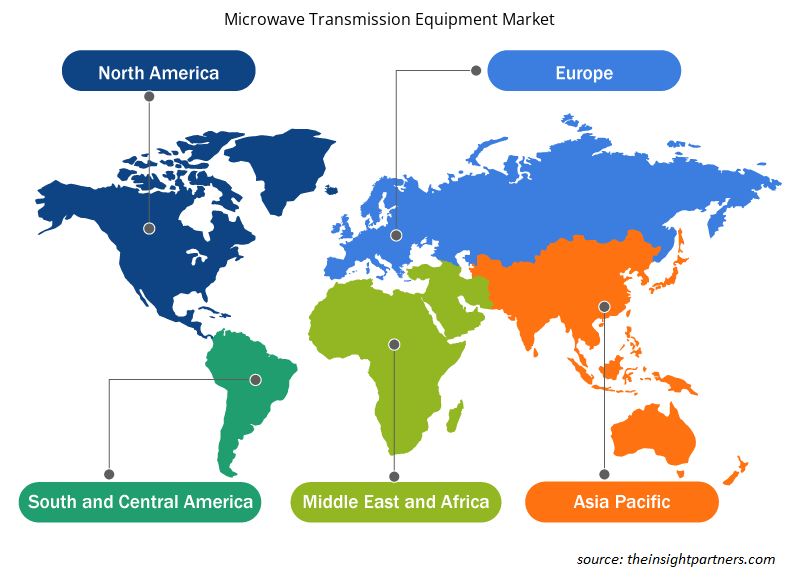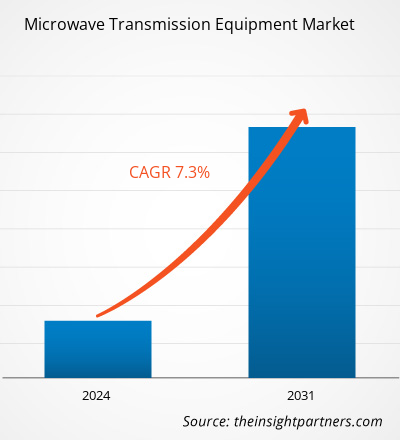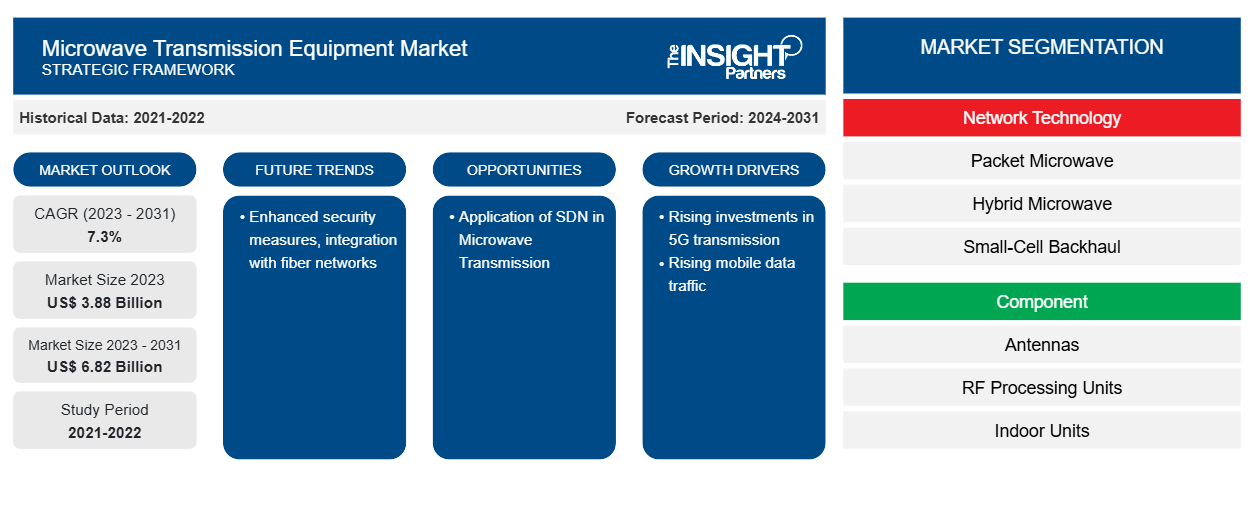من المتوقع أن يصل حجم سوق معدات نقل الموجات الدقيقة إلى 6.82 مليار دولار أمريكي بحلول عام 2031 من 3.88 مليار دولار أمريكي في عام 2023. ومن المتوقع أن يسجل السوق معدل نمو سنوي مركب بنسبة 7.3٪ خلال الفترة 2023-2031. ومن المرجح أن تظل تدابير الأمان المحسنة والتكامل مع شبكات الألياف اتجاهًا رئيسيًا في السوق.
تحليل سوق معدات نقل الموجات الدقيقة
الموجات الدقيقة هي تقنية اتصال لاسلكية في خط البصر تتيح اتصالات لاسلكية عالية السرعة مع القدرة على إرسال واستقبال البيانات والفيديو والمكالمات الهاتفية باستخدام حزم موجات الراديو عالية التردد. تستخدم الاتصالات الراديوية في الفضاء العميق والاتصالات عبر الأقمار الصناعية وأنظمة الاتصالات من نقطة إلى نقطة على الأرض جميعها بشكل متكرر إرسال موجات الميكروويف الراديوية. تستخدم أجهزة الرادار وأنظمة الملاحة الراديوية وأنظمة الاستشعار وعلم الفلك الراديوي أجزاء أخرى من نطاق موجات الميكروويف الراديوية.
نظرة عامة على سوق معدات نقل الموجات الدقيقة
يضطر مزودو الخدمة إلى زيادة سعة نقل البيانات عبر الهاتف المحمول باستخدام كل من تقنيات الألياف/النحاس واللاسلكية بسبب النمو الهائل في حركة البيانات عبر الهاتف المحمول التي يقودها الجيل الرابع والجيل الخامس. تكتسب الاستثمارات في البنية التحتية للجيل الخامس زخمًا عالميًا. علاوة على ذلك، فإن حركة البيانات آخذة في الارتفاع؛ وهذا يستلزم تطوير حلول نقل البيانات التي تنطوي على معدات نقل الموجات الدقيقة. وهذا يقود نمو السوق.
قم بتخصيص هذا التقرير ليناسب متطلباتك
ستحصل على تخصيص لأي تقرير - مجانًا - بما في ذلك أجزاء من هذا التقرير، أو تحليل على مستوى الدولة، وحزمة بيانات Excel، بالإضافة إلى الاستفادة من العروض والخصومات الرائعة للشركات الناشئة والجامعات
-
احصل على أهم اتجاهات السوق الرئيسية لهذا التقرير.ستتضمن هذه العينة المجانية تحليلاً للبيانات، بدءًا من اتجاهات السوق وحتى التقديرات والتوقعات.
محركات وفرص سوق معدات نقل الموجات الدقيقة
ارتفاع الاستثمارات في نقل 5G لصالح السوق
تهدف تقنية الجيل الخامس إلى منح المستخدمين إمكانية الوصول إلى أكثر من 100 ميجابت في الثانية في أي مكان وفي أي وقت. ستكون متوسطات النطاق الترددي القصوى ومتوسطات النطاق الترددي لمحطة قاعدة الجيل الخامس أعلى بعشر مرات من تلك الخاصة بشبكات الجيل الرابع، حيث تصل إلى أكثر من 1 جيجابت في الثانية و10 جيجابت في الثانية على التوالي. أدى تقدم تقنيات الموجات الدقيقة إلى ارتفاع نطاق الموجات الدقيقة من ميجابت في الثانية إلى جيجابت في الثانية. سيمكن نطاق الموجات الدقيقة من 10 جيجابت في الثانية مع تقديم المزيد من التقنيات المبتكرة، بما في ذلك المدخلات المتعددة والمخرجات المتعددة (MIMO)، وتجميع الناقلات (CA)، والنطاق E عالي السعة، والجمع بين النطاق المشترك مع النطاق E. سيغطي هذا متطلبات النطاق الترددي لتحمل الجيل الخامس بالكامل. تم تركيب أكثر من مليوني جهاز ميكروويف على مستوى العالم. في عصر الجيل الخامس، يجب أن تحقق أجهزة الميكروويف أقصى استفادة من معداتها الحالية عن طريق استبدال الأجزاء (مثل اللوحات ووحدات التوزيع الخارجية) بشكل طفيف. بالإضافة إلى حماية الاستثمار الأولي للمشغلين، فإن هذا يسرع من تطوير الجيل الخامس.
تطبيق SDN في نقل الموجات الدقيقة
في ديسمبر 2021، تم تحقيق تقدم كبير في نشر وإدارة الشبكات المحددة بالبرمجيات (SDN) لشبكات الميكروويف من قبل شركة Ericsson وTelefónica Germany / O2. لتمكين مزود خدمة الاتصالات (CSP) من نشر واجهة SDN مستقلة عن البائع في شبكة O2 الوطنية الخاصة بهم، قامت شركة Ericsson بتمكين مجموعة منتجات الميكروويف MINI-LINK الخاصة بها في شبكة O2. وبالتالي، هناك فرص في السوق لمقدمي الخدمة لتعزيز مرونة الشبكة وقابليتها للتوسع باستخدام SDN في نقل الميكروويف.
تقرير تحليل تجزئة سوق معدات نقل الموجات الدقيقة
إن القطاعات الرئيسية التي ساهمت في اشتقاق تحليل سوق معدات نقل الموجات الدقيقة هي تكنولوجيا الشبكة، والمكونات، ونطاق التردد، ونوع التركيب، والتطبيق.
- استنادًا إلى تكنولوجيا الشبكة، ينقسم سوق معدات نقل الموجات الدقيقة إلى الموجات الدقيقة الحزمية والموجات الدقيقة الهجينة والنقل الخلفي للخلايا الصغيرة والإرسال المتعدد بتقسيم الوقت. احتل قطاع الموجات الدقيقة الحزمية الحصة الأكبر في عام 2023.
- بناءً على المكونات، يتم تقسيم السوق إلى هوائيات ووحدات معالجة RF ووحدات داخلية (IDU) ووحدات خارجية (ODU) وكابلات وموصلات.
- بناءً على نطاق التردد، يتم تقسيم السوق إلى نطاق L، نطاق S، نطاق C، نطاق X، نطاق Ku، نطاق Ka، نطاق Q، وغيرها.
- وفقًا لنوع التركيب، يتم تقسيم السوق إلى تركيب داخلي كامل، وتركيب منقسم، وتركيب خارجي كامل.
- وفقًا للتطبيق، يتم تقسيم السوق إلى الملاحة، والاتصالات الخلوية، والاتصالات اللاسلكية، والاتصالات عبر الأقمار الصناعية، والرادار، والاتصالات ذات النطاق العريض.
تحليل حصة سوق معدات نقل الموجات الدقيقة حسب المنطقة الجغرافية
ينقسم النطاق الجغرافي لتقرير سوق معدات نقل الميكروويف بشكل أساسي إلى خمس مناطق: أمريكا الشمالية، ومنطقة آسيا والمحيط الهادئ، وأوروبا، والشرق الأوسط وأفريقيا، وأمريكا الجنوبية والوسطى.
ستستحوذ أمريكا الشمالية على حصة كبيرة من سوق معدات نقل الموجات الدقيقة في عام 2023. وتتمتع المنطقة بعدد كبير من مشاريع طرح الجيل الخامس التي تدعم الطلب على معدات نقل الموجات الدقيقة. كما تدعم الدعم والمبادرات الحكومية في المنطقة بقوة التحول الرقمي في البنية التحتية للاتصالات، وبالتالي دفع نمو السوق في المنطقة.
رؤى إقليمية حول سوق معدات نقل الموجات الدقيقة
لقد قام المحللون في Insight Partners بشرح الاتجاهات والعوامل الإقليمية المؤثرة على سوق معدات نقل الموجات الدقيقة طوال فترة التوقعات بشكل شامل. يناقش هذا القسم أيضًا قطاعات سوق معدات نقل الموجات الدقيقة والجغرافيا في جميع أنحاء أمريكا الشمالية وأوروبا ومنطقة آسيا والمحيط الهادئ والشرق الأوسط وأفريقيا وأمريكا الجنوبية والوسطى.

- احصل على البيانات الإقليمية المحددة لسوق معدات نقل الموجات الدقيقة
نطاق تقرير سوق معدات نقل الموجات الدقيقة
| سمة التقرير | تفاصيل |
|---|---|
| حجم السوق في عام 2023 | 3.88 مليار دولار أمريكي |
| حجم السوق بحلول عام 2031 | 6.82 مليار دولار أمريكي |
| معدل النمو السنوي المركب العالمي (2023 - 2031) | 7.3% |
| البيانات التاريخية | 2021-2022 |
| فترة التنبؤ | 2024-2031 |
| القطاعات المغطاة |
بواسطة تكنولوجيا الشبكة
|
| المناطق والدول المغطاة |
أمريكا الشمالية
|
| قادة السوق وملفات تعريف الشركات الرئيسية |
|
كثافة اللاعبين في سوق معدات نقل الموجات الدقيقة: فهم تأثيرها على ديناميكيات الأعمال
يشهد سوق معدات نقل الموجات الدقيقة نموًا سريعًا، مدفوعًا بالطلب المتزايد من المستخدم النهائي بسبب عوامل مثل تفضيلات المستهلكين المتطورة والتقدم التكنولوجي والوعي المتزايد بفوائد المنتج. ومع ارتفاع الطلب، تعمل الشركات على توسيع عروضها والابتكار لتلبية احتياجات المستهلكين والاستفادة من الاتجاهات الناشئة، مما يؤدي إلى زيادة نمو السوق.
تشير كثافة اللاعبين في السوق إلى توزيع الشركات أو المؤسسات العاملة في سوق أو صناعة معينة. وهي تشير إلى عدد المنافسين (اللاعبين في السوق) الموجودين في مساحة سوق معينة نسبة إلى حجمها أو قيمتها السوقية الإجمالية.
الشركات الرئيسية العاملة في سوق معدات نقل الموجات الدقيقة هي:
- شركة NEC
- شركة هواوي للتكنولوجيا المحدودة
- Telefonaktiebolaget LM إريكسون
- مجموعة سياي ميكرو الكترونيكا
- انتراكوم تيليكوم
- شركة نوكيا
إخلاء المسؤولية : الشركات المذكورة أعلاه ليست مرتبة بأي ترتيب معين.

- احصل على نظرة عامة على أهم اللاعبين الرئيسيين في سوق معدات نقل الموجات الدقيقة
أخبار سوق معدات نقل الموجات الدقيقة والتطورات الأخيرة
يتم تقييم سوق معدات نقل الموجات الدقيقة من خلال جمع البيانات النوعية والكمية بعد البحث الأولي والثانوي، والتي تتضمن منشورات الشركات المهمة وبيانات الجمعيات وقواعد البيانات. فيما يلي بعض التطورات في سوق معدات نقل الموجات الدقيقة:
- أعلنت شركة NEC Corporation (NEC؛ TSE: 6701) اليوم أنها أبرمت اتفاقية نهائية مع شركة Aviat Networks, Inc. (Aviat؛ Nasdaq: AVNW)، الخبيرة الرائدة في حلول النقل والوصول اللاسلكية، لدمج أعمال النقل اللاسلكي الخاصة بها مع شركة Aviat في صفقة شراء أصول بقيمة 70 مليون دولار أمريكي نقدًا وأسهمًا. (المصدر: NEC Corporation، بيان صحفي، مايو 2023)
- أطلقت هواوي الجيل التالي من أجهزة الميكروويف MAGICSwave في المؤتمر العالمي للجوال 2023 في برشلونة. يستخدم MAGICSwave ابتكارات عبر الأجيال لمساعدة المشغلين على بناء شبكات مستهدفة مبسطة موجهة بشكل أفضل نحو تطور 5G على المدى الطويل مع تحسين التكلفة الإجمالية للملكية (TCO) وتطور شبكة النقل بسلاسة. (المصدر: Huawei Technologies Co., Ltd.، بيان صحفي، مارس 2023)
تقرير سوق معدات نقل الموجات الدقيقة والتغطية والنتائج
يوفر تقرير "حجم سوق معدات نقل الموجات الدقيقة والتوقعات (2021-2031)" تحليلاً مفصلاً للسوق يغطي المجالات التالية:
- حجم سوق معدات نقل الموجات الدقيقة وتوقعاتها على المستويات العالمية والإقليمية والوطنية لجميع قطاعات السوق الرئيسية التي يغطيها النطاق
- اتجاهات سوق معدات نقل الموجات الدقيقة، بالإضافة إلى ديناميكيات السوق مثل العوامل المحركة والقيود والفرص الرئيسية
- تحليل مفصل لقوى PEST/Porter الخمس وSWOT
- تحليل سوق معدات نقل الموجات الدقيقة يغطي اتجاهات السوق الرئيسية والإطار العالمي والإقليمي واللاعبين الرئيسيين واللوائح والتطورات الأخيرة في السوق
- تحليل المشهد الصناعي والمنافسة الذي يغطي تركيز السوق، وتحليل خريطة الحرارة، واللاعبين البارزين، والتطورات الأخيرة في سوق معدات نقل الموجات الدقيقة
- ملفات تعريف الشركة التفصيلية
- التحليل التاريخي (سنتان)، سنة الأساس، التوقعات (7 سنوات) مع معدل النمو السنوي المركب
- تحليل PEST و SWOT
- حجم السوق والقيمة / الحجم - عالمي، إقليمي، بلد
- الصناعة والمنافسة
- مجموعة بيانات إكسل
التقارير الحديثة
شهادات العملاء
سبب الشراء
- اتخاذ قرارات مدروسة
- فهم ديناميكيات السوق
- تحليل المنافسة
- رؤى العملاء
- توقعات السوق
- تخفيف المخاطر
- التخطيط الاستراتيجي
- مبررات الاستثمار
- تحديد الأسواق الناشئة
- تحسين استراتيجيات التسويق
- تعزيز الكفاءة التشغيلية
- مواكبة التوجهات التنظيمية























 احصل على عينة مجانية ل - سوق معدات نقل الموجات الدقيقة
احصل على عينة مجانية ل - سوق معدات نقل الموجات الدقيقة